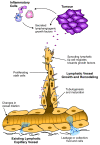Targeting lymphatic vessel functions through tyrosine kinases
- PMID: 20698997
- PMCID: PMC2925338
- DOI: 10.1186/2040-2384-2-13
Targeting lymphatic vessel functions through tyrosine kinases
Abstract
The lymphatic vascular system is actively involved in tissue fluid homeostasis, immune surveillance and fatty acid transport. Pathological conditions can arise from injury to the lymphatics, or they can be recruited in the context of cancer to facilitate metastasis. Protein tyrosine kinases are central players in signal transduction networks and regulation of cell behavior. In the lymphatic endothelium, tyrosine kinases are involved in processes such as the maintenance of existing lymphatic vessels, growth and maturation of new vessels and modulation of their identity and function. As such, they are attractive targets for both existing inhibitors and the development of new inhibitors which affect lymphangiogenesis in pathological states such as cancer. RNAi screening provides an opportunity to identify the functional role of tyrosine kinases in the lymphatics. This review will discuss the role of tyrosine kinases in lymphatic biology and the potential use of inhibitors for anti-lymphangiogenic therapy.
Figures


Similar articles
-
Lymphangiogenic growth factors, receptors and therapies.Thromb Haemost. 2003 Aug;90(2):167-84. doi: 10.1160/TH03-04-0200. Thromb Haemost. 2003. PMID: 12888864 Review.
-
A Three-Dimensional Lymphatic Endothelial Cell Tube Formation Assay to Identify Novel Kinases Involved in Lymphatic Vessel Remodeling.Assay Drug Dev Technol. 2017 Jan;15(1):30-43. doi: 10.1089/adt.2016.764. Assay Drug Dev Technol. 2017. PMID: 28092460
-
Lymphangiogenesis, inflammation and metastasis.Anticancer Res. 2005 Nov-Dec;25(6C):4503-11. Anticancer Res. 2005. PMID: 16334134 Review.
-
Current strategies for modulating lymphangiogenesis signalling pathways in human disease.Curr Med Chem. 2006;13(7):783-92. doi: 10.2174/092986706776055625. Curr Med Chem. 2006. PMID: 16611067 Review.
-
Molecular control of lymphatic metastasis.Ann N Y Acad Sci. 2008;1131:225-34. doi: 10.1196/annals.1413.020. Ann N Y Acad Sci. 2008. PMID: 18519975 Review.
Cited by
-
Digitoxin and its analogs as novel cancer therapeutics.Exp Hematol Oncol. 2012 Apr 5;1(1):4. doi: 10.1186/2162-3619-1-4. Exp Hematol Oncol. 2012. PMID: 23210930 Free PMC article.
-
Lymphatic Tissue Bioengineering for the Treatment of Postsurgical Lymphedema.Bioengineering (Basel). 2022 Apr 6;9(4):162. doi: 10.3390/bioengineering9040162. Bioengineering (Basel). 2022. PMID: 35447722 Free PMC article. Review.
-
Platelet-derived growth factors induced lymphangiogenesis: evidence, unanswered questions and upcoming challenges.Arch Med Sci. 2015 Mar 16;11(1):57-66. doi: 10.5114/aoms.2015.49217. Epub 2015 Mar 14. Arch Med Sci. 2015. PMID: 25861290 Free PMC article.
-
The Lymphatic System in Obesity, Insulin Resistance, and Cardiovascular Diseases.Front Physiol. 2019 Nov 14;10:1402. doi: 10.3389/fphys.2019.01402. eCollection 2019. Front Physiol. 2019. PMID: 31798464 Free PMC article. Review.
-
Soluble Vegfr3 gene therapy suppresses multi-organ metastasis in a mouse mammary cancer model.Cancer Sci. 2020 Aug;111(8):2837-2849. doi: 10.1111/cas.14531. Epub 2020 Jul 4. Cancer Sci. 2020. PMID: 32539229 Free PMC article.
References
LinkOut - more resources
Full Text Sources
Research Materials

